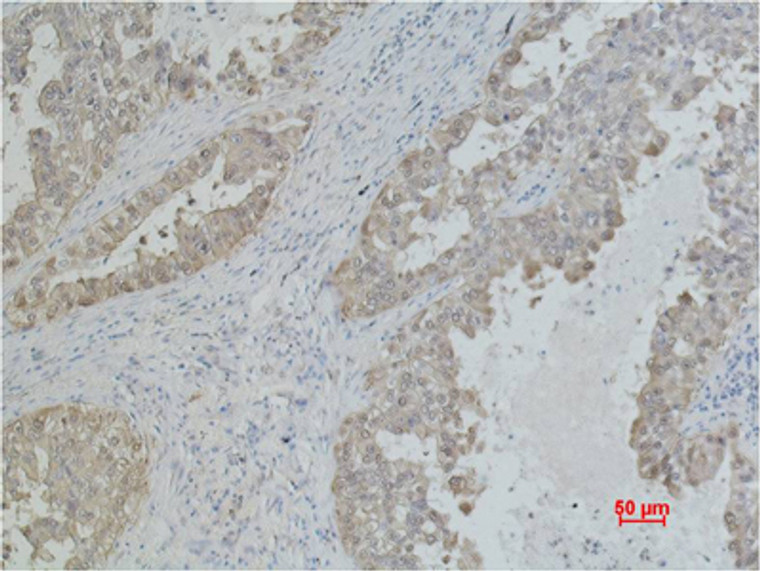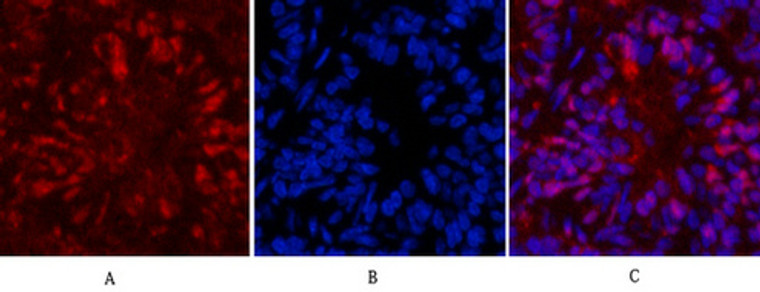-
Western blot analysis of Pig Skeletal Muscle with HSP70 mAb diluted at 1:2, 000.
-
IF analysis of Hela with antibody (Left) and DAPI (Right) diluted at 1:100.
-
Immunohistochemical analysis of paraffin-embedded Human Lung caricnoma using Mouse mAb diluted at 1:500.
-
Immunofluorescence analysis of Rat-testis tissue. 1, HSP70 monoclonal antibody (3G10) (red) was diluted at 1:200 (4°C, overnight). 2, Cy3 labled Secondary antibody was diluted at 1:300 (room temperature, 50min).3, Picture B: DAPI (blue) 10min. Picture A:Target. Picture B: DAPI. Picture C: merge of A+B
-
Western blot analysis of 1) Hela, 2) Mouse Brain, diluted at 1:2000.
-
Immunofluorescence analysis of Human-breast-cancer tissue. 1, HSP70 monoclonal antibody (3G10) (red) was diluted at 1:200 (4°C, overnight). 2, Cy3 labled Secondary antibody was diluted at 1:300 (room temperature, 50min).3, Picture B: DAPI (blue) 10min. Picture A:Target. Picture B: DAPI. Picture C: merge of A+B
-
Immunofluorescence analysis of Mouse-lung tissue. 1, HSP70 monoclonal antibody (3G10) (red) was diluted at 1:200 (4°C, overnight). 2, Cy3 labled Secondary antibody was diluted at 1:300 (room temperature, 50min).3, Picture B: DAPI (blue) 10min. Picture A:Target. Picture B: DAPI. Picture C: merge of A+B
-
Immunohistochemical analysis of paraffin-embedded Mouse-lung tissue. 1, HSP70 monoclonal antibody (3G10) was diluted at 1:200 (4°C, overnight). 2, Sodium citrate pH 6.0 was used for antibody retrieval (>98°C, 20min). 3, Secondary antibody was diluted at 1:200 (room tempeRature, 30min). Negative control was used by secondary antibody only.
-
Immunohistochemical analysis of paraffin-embedded Rat-testis tissue. 1, HSP70 monoclonal antibody (3G10) was diluted at 1:200 (4°C, overnight). 2, Sodium citrate pH 6.0 was used for antibody retrieval (>98°C, 20min). 3, Secondary antibody was diluted at 1:200 (room tempeRature, 30min). Negative control was used by secondary antibody only.
-
Immunohistochemical analysis of paraffin-embedded Human-uterus-cancer tissue. 1, HSP70 monoclonal antibody (3G10) was diluted at 1:200 (4°C, overnight). 2, Sodium citrate pH 6.0 was used for antibody retrieval (>98°C, 20min). 3, Secondary antibody was diluted at 1:200 (room tempeRature, 30min). Negative control was used by secondary antibody only.
-
Western blot analysis of lysates from HT-29, NIH/3T3, and HepG2 cells, primary antibody was diluted at 1:1000, 4°C over night, secondary antibody (cat: (NA) was diluted at 1:10000, 37°C 1hour.
-
Immunofluorescence analysis of Hela cell. 1, AIM2 Polyclonal Antibody (red) was diluted at 1:200 (4°C overnight). HSP70 monoclonal antibody (3G10) (green) was diluted at 1:200 (4°C overnight). 2, Goat Anti Rabbit Alexa Fluor 594 Catalog: (NA was diluted at 1:1000 (room temperature, 50min). Goat Anti Mouse Alexa Fluor 488 Catalog: (NA was diluted at 1:1000 (room temperature, 50min).

















